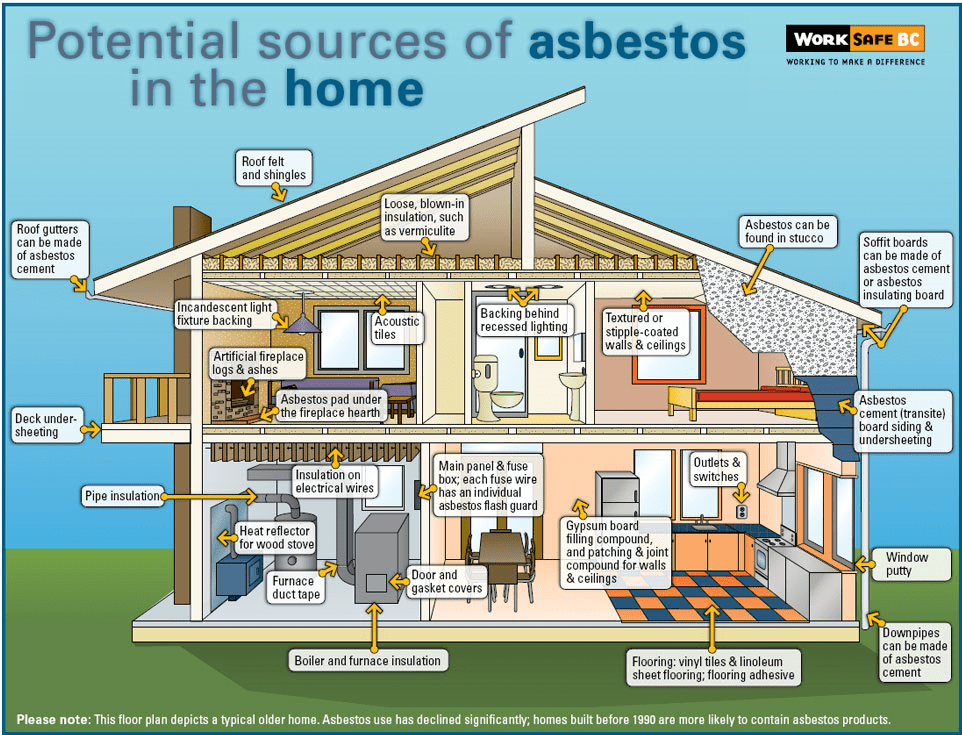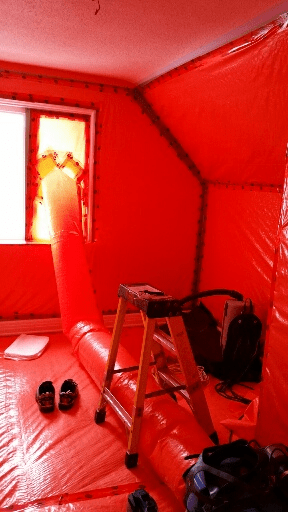If your home was built before 1990 (as many homes are), if you’re planning to take on a home improvement project (as many people are), and if you don’t know about asbestos (as many people don’t), then this article is for you! We will walk you through WHAT asbestos is, WHERE it can be found, WHY it should matter to you, and most importantly, HOW you can prevent it from becoming a health concern for you, your family, and anyone you have working on your home.
What is asbestos?
Asbestos is a naturally occurring mineral that was previously appreciated for its versatility, heat resistance, tensile strength and insulating properties. There are six types of asbestos, and while all were used for a variety of purposes, in 1987 it was declared a human carcinogen by the World Health Organization and is now banned in over 50 countries.
Where is asbestos found?
Asbestos was previously used in over 3,000 applications, from fire-proof vests to home and commercial construction, woven into fabric or mixed with cement. Thanks to its properties, it was most commonly used for insulating buildings and homes against cold weather and noise, as well as for fireproofing.
After being declared a carcinogen in 1987, the use of asbestos drastically and quickly declined. However, due to its prevalence before then, almost every home built from 1900 to 1990 includes asbestos products in some way. Its residential uses commonly included:
- Attic insulation (vermiculite)
- Resilient floor tiles (vinyl, linoleum)
- Vinyl siding
- Textured ceiling finishes
- Roofing compounds, shingles and felt
- Sealants and insulation surrounding furnaces, plumbing and fireplaces
- Window caulking
- Drywall compound (plaster)
- Ceiling tiles
Check out this document for a more comprehensive list, with photos, of common residential building materials. (Source: Ontario Environmental & Safety Network Ltd. Presentation, Niagara Regional Housing)

What are the health risks?
Breathing in asbestos fibres can lead to very serious illnesses, including asbestosis (scarring of the lungs), mesothelioma (cancer of the chest or abdominal lining) and lung cancer.
While this sounds very scary (and if managed incorrectly – is!), it’s important to note that there are no significant health risks if asbestos remains undisturbed in your home. If it is in good condition, sealed behind walls or floorboards, or isolated in your attic, asbestos in the products or materials used in the construction of your home is virtually harmless.
How can you be exposed to asbestos?
The importance of asbestos to the renovation industry, and why we’re highlighting it in these tips, is that asbestos becomes dangerous when it is disturbed. Therefore, when renovating or demolishing areas of the home, this friable material can release small fibres into the air and place everyone in the home at risk (both your family and our workers).
At other times, only if a material is damaged (eg. tearing or cracking) will it become possible for the asbestos fibres to be airborne. Take care not to touch the product as you are examining it, as you may further release fibres into the air.
How does asbestos affect your home improvement plans?
Many homeowners aren’t aware they are legally responsible for ensuring their home is safe from airborne asbestos. (Just as the contractor is legally responsible for ensuring a safe worksite for their employees.) Therefore, if your home was built before 1990, as part of our procedure at Amsted, we will recommend testing in the areas that will see work. Not only does this keep everyone safe, it allows us to incorporate any necessary asbestos removal into the scope of work from the beginning, so that we are designing a renovation that remains within your desired investment.
What does asbestos testing entail?
A qualified testing company will take samples from the areas of work, in order to test each and get a reading on the amount of asbestos, if any, contained in the materials. They will produce for you, the homeowner, a written report of their findings (called a Designated Substance Report), and their recommendations for remediation, if necessary. If work is continued at the site before the asbestos is safely removed, the Ministry of Labour has the right to halt all work at the home.
What does asbestos removal entail?
There are three types of asbestos removal recommendations, based on the level of asbestos in a material and the surface area that will be disturbed in the process of your renovation. There are strict procedures that must be followed when working on these different types of remediation, and all must be followed by a licensed abatement contractor.
The photos below showcase an example of the containment procedures required to maintain a safe environment throughout the removal. This project was set up and completed in a single day by our sister company, Steamatic, and included the removal of the stipple ceiling.
We encourage you to contact us at any point in your renovation planning should you have any questions about asbestos in your home. We are happy to provide references for testing, or help you secure the testing through our partners. And if your home comes back positive, we can discuss your options and create a plan of action that will keep you and your family healthy and safe while we create a home that is unmistakably yours!
More on harmful substances and the homeowner’s responsibility
Resources
Health risks of asbestos, Government of Canada
Asbestos – In the Home, Canadian Centre for Occupational Health and Safety
A Guide to Asbestos Management, Presentation by Ontario Environmental & Safety Network Ltd.

